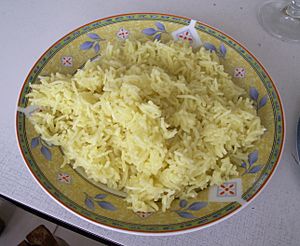Rice allergy facts for kids
Rice allergy is when your body has a bad reaction to rice. This happens because your body's immune system mistakes certain proteins in rice as harmful. People with this allergy might react after eating rice or even breathing in steam from cooked rice. While some reactions can be serious, doctors can help find out if you have a rice allergy and how to avoid problems.
Contents
What Are the Symptoms?
When someone has a rice allergy, their body reacts to specific rice proteins. After eating rice or breathing its steam, they might experience different symptoms.
Common Reactions
- Runny nose or sneezing
- Itchy skin or eyes
- Asthma (trouble breathing or wheezing)
- Stomachache
- Eczema (itchy, red skin patches)
More Serious Reactions
Sometimes, reactions can be more serious. These might include:
- Skin rashes and swelling
- Feeling dizzy or faint
- Having a lot of trouble breathing
- In very rare and serious cases, a severe reaction called anaphylaxis can happen. This needs immediate medical help.
How Is Rice Allergy Diagnosed?
If someone thinks they might have a rice allergy, doctors have a few ways to find out for sure.
Trying an Avoidance Diet
One way to check is to try avoiding rice for a few weeks.
- First, stop eating all rice and foods with rice in them.
- If your symptoms go away during this time, but then come back when you eat rice again, it's a strong sign you might be allergic.
- Always do this with a doctor's advice.
Blood Test for Antibodies
Doctors can also do a blood test.
- When you are allergic to something, your body makes special antibodies called IgE.
- A blood test can measure the level of specific rice IgE in your blood.
- If the level is high, it suggests you have a rice allergy.
Skin Prick Test
The skin prick test is a quick and common way to diagnose allergies.
- A doctor will put a tiny drop of liquid with rice protein on your skin.
- Then, they gently prick the skin through the drop.
- If you are allergic, the spot will become red, itchy, and swell up like a small mosquito bite within about 30 minutes.
How Is Rice Allergy Treated?
While there's no cure for rice allergy, there are ways to manage it and reduce reactions.
Allergy Shots
Some people might get allergy shots.
- These shots contain tiny amounts of the rice protein.
- Over time, getting these shots can help your body get used to the protein.
- For some people, this can make their reactions much weaker or even stop them completely.
Avoiding Rice
The most common way to manage a rice allergy is to avoid rice.
- This means not eating rice or foods that contain rice ingredients.
- Reading food labels carefully is very important.
- Staying away from rice for a long time can help reduce reactions.
Genetically Modified Rice
Scientists are also looking into new options.
- Some research has explored using genetically modified rice.
- This special rice might have fewer of the proteins that cause allergic reactions.
- It could be a future choice for people with rice allergy.
How Common Is Rice Allergy?
Rice allergy is not as common as some other food allergies, like peanut or milk allergies.


